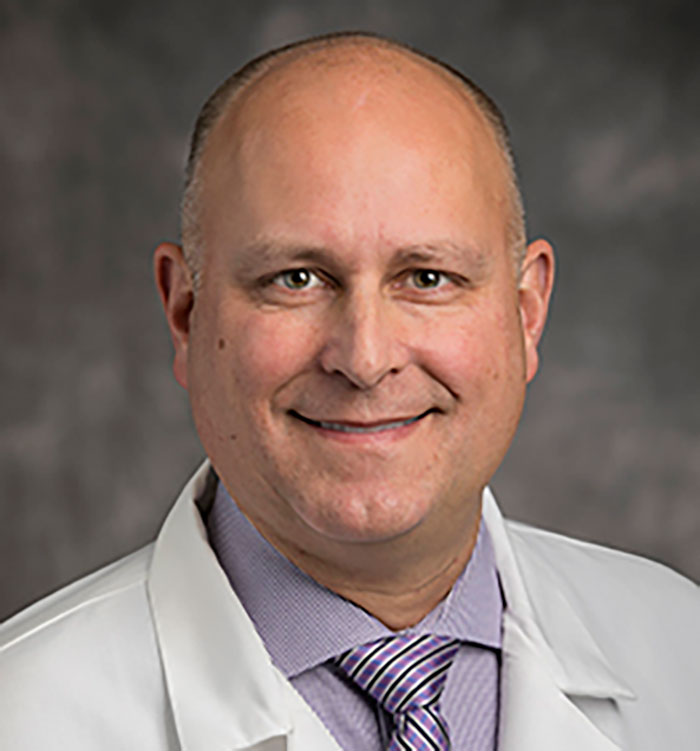Study Aims to Reduce Post-surgical Scarring in Tracheal and Laryngeal Injury
November 13, 2019
Developing a Biologic Bandage
Innovations in Ear, Nose & Throat | Fall 2019
 N. Scott Howard, MD, MBA
N. Scott Howard, MD, MBAA challenging phenomenon occurs during the healing process of laryngotracheal wounds, whether they were caused by external trauma, disease or iatrogenic injury. “Immediately after surgical repair, the tissue will look beautiful,” says N. Scott Howard, MD, MBA, Director, University Hospitals Center for Voice, Airway and Swallowing Disorders and Assistant Professor, Case Western Reserve University School of Medicine. “However, when the patient returns weeks later, the immune system has responded in a way that is often not beneficial to healing, and we visualize a robust scar.”
A retired U.S. army colonel, Dr. Howard has a passion for airway research that stems from years of treating combat veterans and their families on military bases around the country. Now, Dr. Howard is spearheading a collaboration among University Hospitals Cleveland Medical Center, Cleveland Clinic, and Case Western Reserve University to develop a biologic bandage capable of adhering to the mucosal surface of laryngotracheal tissue. The research is being funded through a $250,000 grant from the Department of Defense U.S. Army Medical Department (AMEDD) Advanced Medical Technology Initiative (AAMTI), which transferred to Case Western Reserve University when Dr. Howard relocated to Cleveland.
“The grant is one aspect of the overall vision for where I would like our program to go as we build a comprehensive airway center here at University Hospitals Cleveland Medical Center,” says Dr. Howard. “We are excited about the opportunity to partner with experts from our distinguished neighboring institutions on this novel investigation.”
RESEARCH OVERVIEW
Using a rabbit model of tracheal stenosis, researchers will simulate an injury to the airway. A primary aim of the study is to reduce or eliminate the formation of a cicatrix of scar through the placement of a durable biologic bandage matrix that can be introduced into the confined airway space and secured to the affected mucosal tissue. As the team monitors the efficacy of the bandage, the ideal outcome is for healthy cells to grow within the matrix so that it is incorporated into the surrounding tissue.
Ideal biologic bandage properties include:
- readily introduced into the airway
- easily secured in place
- applied during a single operation
- long shelf life
- ready to use
- nonantigenic
- flexible and durable
- able to prevent infection/fibrosis
- inexpensive
NANOPARTICLES AND THE EMBRYOTIC RESPONSE
A key factor in reducing post-injury morbidity is the ability of the dressing to deliver cellular signals to the site that influence a positive healing response. “We know that in utero, remodeling is happening throughout development, but scars don’t develop,” says Dr. Howard. “Embryotic wounds tend to have low levels of transforming growth factors TGF-β1- and TGF-β2 and high levels of TGF-β3. We intend to target the injury’s environment to mimic the embryotic profile.”
Utilizing drug-eluding nanoparticles, the team will be able to effectively disperse uniform doses of therapeutic agents over an extended period of time. Anand Ramamurthi, PhD, a researcher in the Department of Biomedical Engineering at Cleveland Clinic and Professor of Biomedical Engineering and Molecular Medicine, Cleveland Clinic Lerner College of Medicine of CWRU, will work to develop PLGA-based nanoparticle formulations that will be chemically-tethered onto these biologic bandages in order to enable controlled and sustained delivery of a “payload” of selected drugs to the targeted site to modulate the healing responses in the airway.
An additional objective is the investigation of histopathological effects of the various biologic bandage combinations on the tissue. With rabbits randomized to biologic bandage or no biologic bandage, the team will study the best dressing combinations by comparing the degree of fibrosis, distribution of collagen and markers of inflammation through immunohistochemistry. Following humane euthanasia, each larynx and trachea will be preserved for histological analysis, with the control animals serving as valuable benchmarks.
As the applicability of nanoparticles continues to be explored in a variety of disciplines, findings from this pilot study may have far-reaching implications. “In addition to encouraging appropriate healing and improving outcomes for laryngeal injury and tracheal stenosis, this concept has potential beyond otolaryngology as a biocompatible method for delivery of a wide variety of therapeutic agents,” says Dr. Howard.
For more information, call the University Hospitals Ear, Nose & Throat Institute at 216-868-8943 or contact Dr. Howard at N.Scott.Howard@UHhospitals.org.


